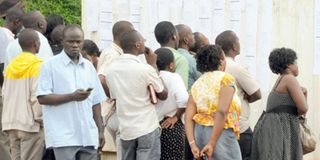To improve youth livelihood, put emphasis on the ICT sector

What you need to know:
Over time, we have seen programmes like the Entandikwa, prosperity for all, Youth livelihood, women empowerment and Operation Wealth Creation (OWC) in the early 2000. These have all metamorphosed into the more versatile and receptive Parish Development Model.
Over the last couple of years, the NRM government has declared war on poverty. In the foreword of the party Manifesto for the year 2021-2026, the NRM Chairman and President of Uganda states that the government has met most of the goals and aspirations of Ugandans, He states that giant steps have been made to improve the lives of Ugandans and the next steps are to improve the livelihoods of Ugandans. Indeed this is evident. Today, less children are dying at birth than used to in the 1980s and 1990s. Access to health care is easier and so is access to education.
In its endevour to improve the livelihoods of Ugandans, the government has designed programmes to engage the citizens in income-generating activities. Over time, we have seen programmes like the Entandikwa, prosperity for all, Youth livelihood, women empowerment and Operation Wealth Creation (OWC) in the early 2000. These have all metamorphosed into the more versatile and receptive Parish Development Model.
A close look at the various programmes will reveal remarkable progress in their purpose of transforming the lives of Ugandans.
In particular, the OWC has been significant in reducing subsistence production, with a significant leap of the 32% population that was involved in the money economy by 2014 increase to 61% to date. The vision of the government is to further reduce the remaining 39% left in subsistence production to a single digit in the near future.
Government in 2021 introduced Emyooga in 2021 to complement OWC by creating two million jobs annually. Every rural constituency and a Kampala city Division under this initiative received Shs30 million and Shs50 million respectively as seed capital for people organised into SACCOs to utilize in the 17 specialized enterprises like carpentry, produce dealing, metal fabrication among others.
So far, over Shs200 billion has been injected into the SACCOS countrywide and benefits are vivid with many people now joining the money economy from subsistence production, according to the Emyooga National Coordinator, Ms Ritah Namuyenge.
President Museveni while in West Nile recently on a wealth creation tour revealed that the government settled for the Parish development model because of its proximity to intended beneficiaries and reduced bureaucracies which have existed in previous programs.
He believes that PDM, if well-handled, is likely to be a magic bullet to the uplifting of livelihoods among many households and social economic transformation of communities.
This then begs the question of how youth, 70 percent of Uganda’s population, living in peri-urban or urban areas can tap into the PDM to earn an income. This scheme in my view was unconsciously designed to diagnose money challenges among the uneducated rural peasants and so, a similar strategy cannot be adopted to tackle concerns of urban youth dwellers. Even when this group is allocated a bigger share of the money, the focus is on agriculture yet fresh graduates do not own land or even money to hire space for farming.
Although I back proponents of this initiative to reduce household poverty, I also think when it comes to the urban setting, a review needs to be done to align the program with people’s prevailing conditions.
Much emphasis by government and development partners can be put on the ICT sector, services and industry because it can easily absorb the youth as employees much faster than insisting on using the long route of agriculture.
The government needs to put in place favorable conditions like offering free land to potential investors, tax holidays, extension of good roads and power to boost production hence, recruiting more workers to meet the production demand.
Soveriegn Hasashya, Youth leader, Butaleja District




